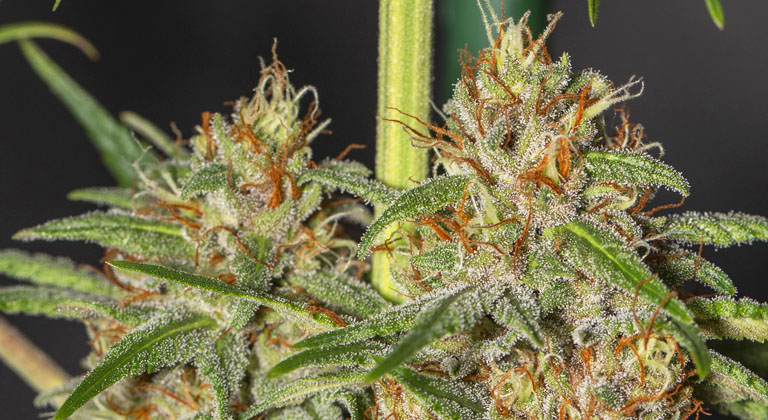Improve the quality and yield of cannabis plants by utilizing various pruning techniques. Different methods are suitable for indoor and outdoor grows, and it’s important to consider the specific strain and ideal pruning time for successful results. This article provides an overview of the different types of pruning techniques used on cannabis plants.
What is Pruning?
Pruning is an agricultural practice that involves cutting branches to direct plant growth and increase yield. This technique can be applied to cannabis plants to enhance bud production.
Each cannabis strain has a unique growth pattern, so it’s crucial to choose a pruning technique that suits the selected strain and grow conditions. Consider these techniques when planning your grow and select the method that best matches your needs.
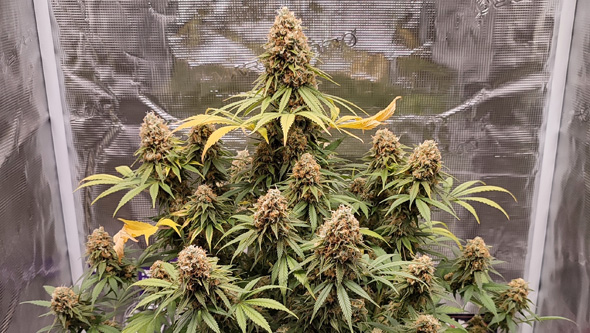
What Tools are Needed to Prune Cannabis?
For cannabis pruning, you’ll need a cutting tool such as bonsai scissors or classic round or flat-tipped scissors. It’s essential to keep the tools sharp to avoid tearing the plant’s tissues. Sanitizing the tools with alcohol is also important to reduce the risk of viral diseases.
Precision may be required for certain techniques, such as pruning small branches or applying apical or FIM pruning. In these cases, a scalpel can be used to ensure a clean cut without damaging the plant. Additional materials like plastic-coated flat wire, trellis netting, and stakes may be needed for specific pruning and bending techniques.
Basic tools needed for pruning cannabis include:
- Sharp scissors or a scalpel
- Alcohol
- Wire or stakes
- Adhesive tape
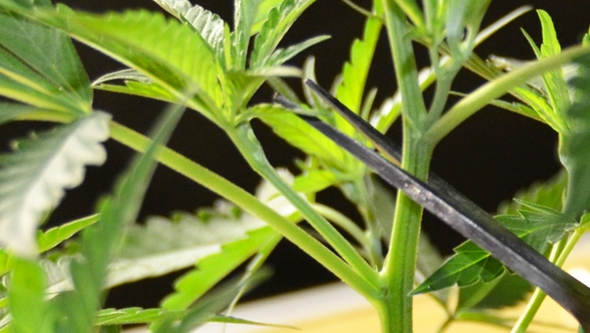
Types of Cannabis Pruning Techniques
Several pruning techniques can be applied to cannabis plants, each with its own advantages and suitable conditions. Let’s explore these techniques:
Apical Pruning
Apical pruning is a commonly used technique that involves cutting the top of the plant to promote the growth of secondary branches.
What is apical pruning?
The top of the plant, known as the “apical bud” or branch, contains high concentrations of auxins that inhibit the growth of secondary branches. By cutting this tip, two stems form, allowing more attention and strength to be distributed to the secondary branches.
This technique is suitable for both indoor and outdoor plants, preferably those with strong and rapid growth patterns, such as sativa-dominant hybrids.
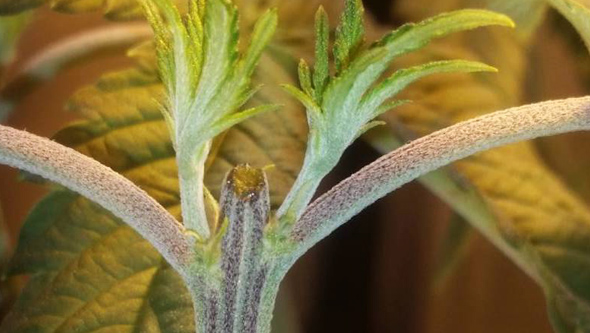
What are the advantages of apical pruning?
- Increased bud production from more branches
- Morphological changes resulting in a bushier plant, beneficial for discreet outdoor grows
How to use the Apical Pruning Method on Cannabis Plants?
Apical pruning should be performed during the growth phase, never during flowering. It’s recommended to perform the pruning at least from the third node counted from the bottom up. In outdoor grows, pruning can be done until mid or late June in the northern hemisphere and December in the southern hemisphere. Give the plant enough time to develop after pruning for the best results.
Do not prune during flower or close to the flowering period, as it may reduce yield.
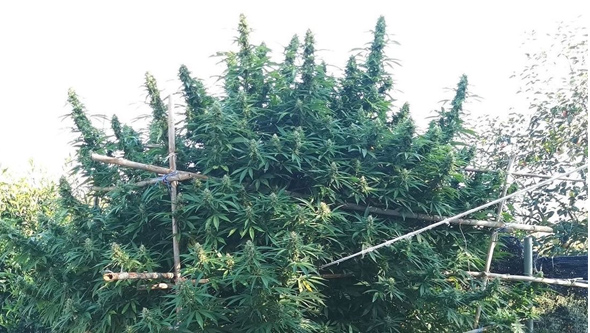
Lollipop Pruning
Lollipop pruning involves removing unproductive branches to redirect the plant’s energy towards bud production.
What is lollipop pruning?
Lollipop pruning focuses on removing branches that don’t contribute to bud production. This technique requires experience in identifying the correct branches to remove, as each strain may respond differently.
What are the advantages of lollipop pruning?
- Improved nutrient allocation for bud and supporting branch development
- Better air circulation in indoor grows, reducing the risk of fungi
How to Lollipop Prune Cannabis Plants
Lollipop pruning is performed during the late growth stage and the start of the flowering period. Begin by removing the smaller branches closest to the roots and stop at the desired height. Customize the pruning based on your needs and preferences.
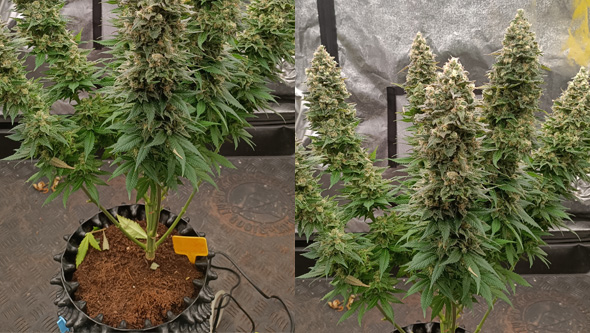
FIM Pruning
FIM pruning is a popular technique that can produce excellent results and is suitable for growers of all levels.
What is FIM pruning?
FIM pruning allows for the growth of multiple shoots from a single node. It’s a simple technique that can be used for both indoor and outdoor grows.
What are the advantages of FIM pruning?
- Increased yield
- Reduced risk of fungal attacks in dense bud strains
- Maximizing space efficiency with fewer plants
- Similar to apical pruning, strength is distributed to secondary branches
How to Use the FIM Pruning Technique on Cannabis
In FIM pruning, only two-thirds of the stem is cut instead of the entire top. After a few days, new shoots will emerge from the cut.
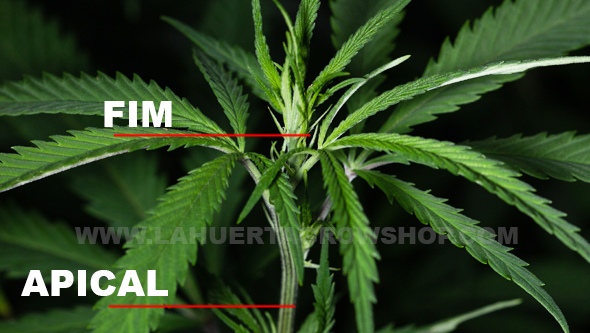
LST Pruning
LST pruning, also known as Low Stress Training, involves bending the plant to improve its overall yield. This method requires regular interaction with the plants.
What is the LST technique?
Low Stress Training combines apical pruning with bending techniques to encourage horizontal plant growth. It can be used for both indoor and outdoor grows.
What are the advantages of the LST method?
- Stronger secondary branches due to apical pruning
- Improved light exposure for the entire plant
- More branches with sufficient light result in higher bud production
How to apply the LST technique to cannabis plants
The LST method is suitable for non-autoflowering feminized and regular strains, especially those with strong and dense growth patterns. The technique involves:
- Performing apical pruning first
- Bending and securing two lateral branches that emerge from the apical pruning
- Allowing vertical stems to grow from the bent branches for bud development
This pruning technique should begin early in the growth stage, once the plant has surpassed three nodes. The goal is to achieve well-developed lateral branches during the growth phase.
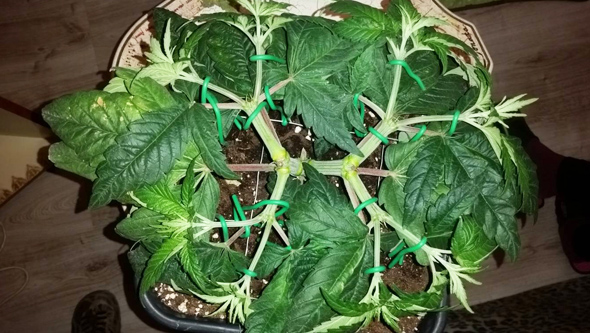
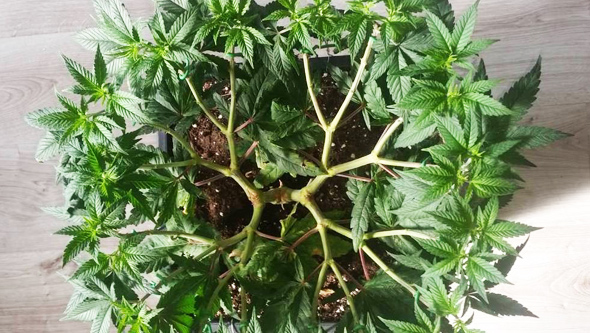
RIB Technique
The RIB technique, which stands for “Right, I Burned it”, involves intentionally burning the tip of a bud to stimulate increased calyx production.
What is RIB pruning?
RIB pruning aims to divert the plant’s energy towards healing the burned buds, resulting in more calyxes and larger buds.
What are the benefits of RIB pruning?
This technique originated from observing plants that had accidentally burned bud tips. The benefits include:
- Regeneration of bud areas with increased cell division
- Production of larger buds
How to apply the RIB pruning technique to Cannabis Plants?
The RIB technique is most effective with balanced hybrid strains. It’s recommended to apply this technique at least four weeks into the flowering stage, ensuring there is enough room for bud development.
Burn only the upper part of the bud with a turbo lighter or a Minitube Clipper. This extends the flowering period, so consider your grow’s timing before applying the technique to the entire crop.
Super Cropping Technique
The super cropping technique involves bending the plant’s stems to promote increased bud production without cutting.
What is the Super Cropping method?
Super cropping directs the plant’s growth by applying controlled bending to branches. It’s similar to apical pruning but without cutting the stem.
What are the benefits of Super Cropping?
- Enhanced development of secondary branches
- Increased size of central bud due to strengthened stem
- Better height control in indoor grows
How to Super Crop Cannabis Plants?
Select the branches for bending and gently bend them in the desired direction. Avoid breaking or separating the stems. Use insulation tape, packing tape, or duct tape if a stem breaks. The bent area will thicken to provide greater support and increase bud size.
Stem Pinching or Pinching
The stem pinching technique involves gently pressing and cracking the stem to stimulate growth hormone distribution among branches.
What are the advantages of stem pinching?
- Enhanced development of secondary branches
- Horizontal growth and bushy plant shape for increased bud production
- Minimal stress on the plant, ensuring overall health
How to pinch or prune the stem
Perform stem pinching during the first half of the growth stage, once the plant has more than three nodes. Gently press the stem with your index and thumb until you hear a “crack.” This technique is milder than apical pruning and super cropping, ensuring minimal stress to the plant.
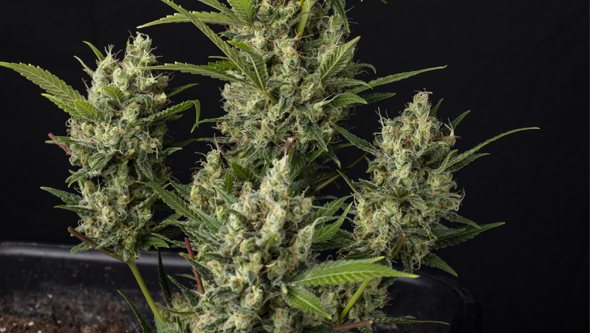
Types of pruning and autoflowering plants
Autoflowering plants, which have Ruderalis genetics, flower independently of sunlight after reaching maturity. Their short growth period, typically ranging from 3 to 5 weeks, followed by rapid flowering, does not benefit from pruning techniques. The stress caused by pruning may negatively impact the results of autoflowering strains. It’s recommended to grow the strain a few times without pruning to understand its specific growth pattern.
If you have any questions or would like to share your opinion, feel free to leave a comment below!
La Huerta Grow Shop!
FAQs
1. Which pruning technique is best for indoor grows?
The best pruning technique for indoor grows depends on the specific strain and grow conditions. Techniques like apical pruning, FIM pruning, and LST pruning are commonly used in indoor setups.
2. Can pruning be done during the flowering stage?
Pruning should generally be avoided during the flowering stage, as it can stress the plant and reduce yield. It’s best to perform pruning techniques during the growth phase.
3. Is it necessary to sanitize pruning tools?
Yes, it is important to sanitize pruning tools before and after use to minimize the transfer of viral diseases. Cleaning the tools with alcohol is recommended.
4. Are there any pruning techniques suitable for autoflowering plants?
Autoflowering plants have a short growth period and may not benefit from pruning techniques. It’s generally recommended to avoid pruning autoflowering strains.
5. Can super cropping be used in combination with other pruning techniques?
Yes, super cropping can be combined with other pruning techniques like apical pruning or LST pruning to enhance the plant’s overall yield and shape.


